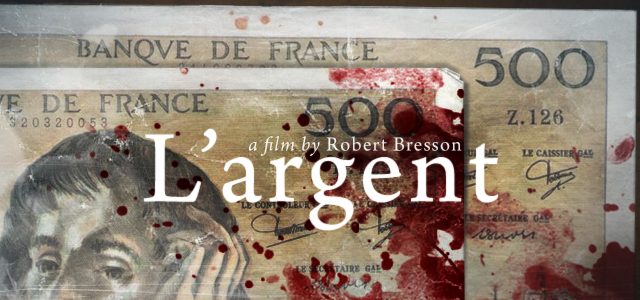Robert Bresson was born in rural France in 1901, John Landis in Chicago in 1950. Bresson was a Catholic, with all that entails, and Landis is secular, directing godless films for a godless world. Bresson is fatalistic while Landis is more anarchic. Bresson is a minimalist and Landis directed The Blues Brothers. Yet these filmmakers who both made films in 1983, films which couldn’t be more different, are united in their materialism: Landis and Bresson are obsessed with the things of the world, and the things that people do.
Bresson saved L’argent for last; an adaptation of Tolstoy’s The Forged Coupon, it tracks a forged bank note from sale to sale in the sober, ascetic form that Bresson was known for. It is a story about circulation, showing the starting point (lies) and the endpoint (murder) of a banknote which is phony. But according to Bresson, so is every banknote. This film could’ve just as easily been titled Trading Places for how often we’re shown the way that money trades places. A bank note travels from the rich to the poor to the middle class, and in the words of Ignatiy Vishnevetsky, Bresson displays that “the middle-class conception of the evil and distant ‘system’ is just a way of avoiding moral responsibility and facing the fact that the middle class is the system itself.”
Unlike L’argent, and also unlike most American tales of class, there is no sense of the middle class in Trading Places. It is a film about a poor man, a rich man, and two richer men who have a sporting debate about nature and nurture. Can they effectively swap the place of two men, a white stockbroker and a black petty criminal, and expect both of these men to fulfill the other’s roles? Is there any sort of natural explanation for poverty, or is it purely a question of environment? Landis correctly identifies the answer: both of these men are criminals, and so their roles are easy to swap. Billy Ray becomes ruthless and high-class, immediately changing his perspective once he has something to lose, and Winthorpe becomes desperate as soon as he has nothing to lose. The thesis then doesn’t come down on nature or nurture, it comes down on what you’ve got in the bank.
Their materialism bleeds through to their similarly radical (though radically different) filmmaking styles. Bresson’s tactile filmmaking tracks using only concrete cuts and simply framed shots, though he frequently makes use of mirrors in a more abstract way. He is always careful about the setting, staging scenes in environments that highlight his rich-poor-middle-class-farm-prison story journey. Landis is just as concerned with these settings, taking care to highlight Winthorpe’s mansion and Billy Roy’s not-so-nice apartment. Though more maximal, it’s equally concrete and physical. There is a Bressonian quality to the opening montage, which cuts directly from homeless people sleeping on the streets of New York, to the wealthy Winthorpe waking up in his mansion, greeted by his butler. American films, especially comedies (especially ones from the 80s) do not address class in this direct a manner.
These are both films about the way that money moves, the way that the circulation of currency makes monsters out of men, and how “we are all each other’s oppressors when we could just as easily be each other’s saviors”. This is true of the end of Trading Places, where Winthorpe and Billy Ray swindle the Dukes out of their money using an elaborate financial trick (which economists are still debating). There is a tragic and comic sensibility to the way money is constantly being invented and misplaced, its slippery spatial mechanics are like the macguffins of Shakespearean comedy (and Benny Safdie believes that L’argent is really a dark comedy). These are films about the things that become misplaced in an exchange.
They’re also about the exchange of a glance. The most memorable image in L’argent, the last image in Bresson’s career, is the image of a French town looking into a cafe upon the murderer that they’ve made, and as he leaves the room, they are still looking in at the empty space, and at the world that created. There is a memorable glance in Trading Places as well:

It’s a silly glance, given from Billy Ray to the viewer as Winthorpe is patronizing him, but this direct address implicates the viewer in their patronizing explanation. Isn’t it silly that they think just because Billy Ray is black, he doesn’t know what a bookie is? At every moment, Landis expects you to understand the absurdity, and make judgements about the immorality of what’s going on.
Both films conclude in an explosion of violence, most of it offscreen, much of it shocking. The gorilla incident in Trading Places is horrifying if you really think about it, and the offscreen violence that concludes L’argent is just as horrifying, mostly to think about it as the last thing that Bresson would ever put onscreen. These films reduce the trading of currency to the catharsis of violence, farcical violence and horrible violence. The dog in L’argent can be seen as sort of a mirror to the gorilla in Trading Places. Silent, animalistic observers to the animal acts committed by man.
It would be a mistake to overstate the radicalism of Trading Places (it ends with blackface after all), but it would also be a mistake to understate it. This film, made by the wealthy 1980s comedy masters, seems to loathe wealth just as much as the french marxists. Can there really be an effective treatment on the corruption of wealth made by a man with a net worth of $70 million, who lives in a penthouse in Chicago? To answer a question with a question, can there be an effective treatment on the corruption of wealth made by a modest-living 83-year-old man in rural France?

